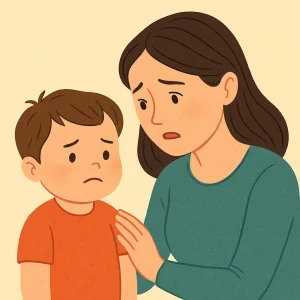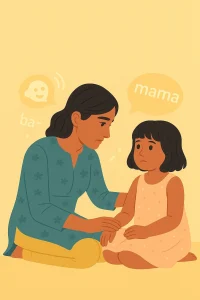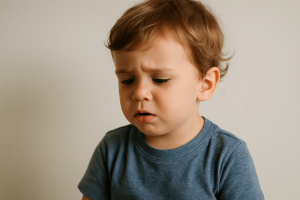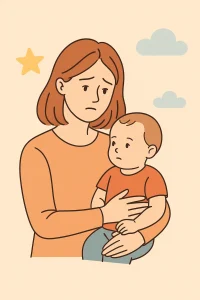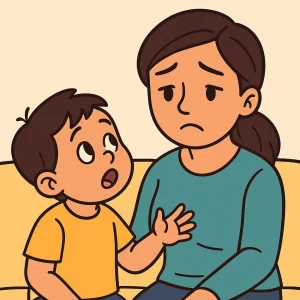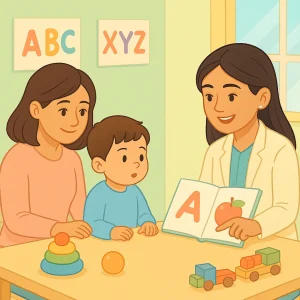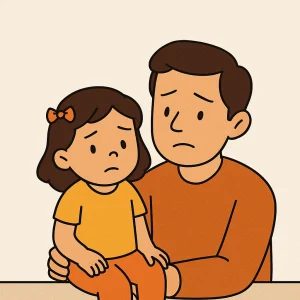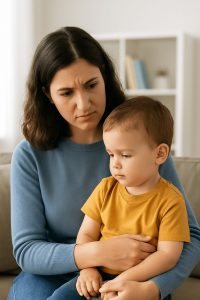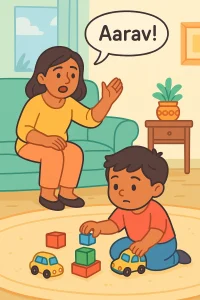Understanding and Managing Your Child’s Drooling: A Simple Guide for Parents
By Rajini D
Last Updated: March 11, 2024
Drooling, the unintentional flow of saliva outside the mouth, is a typical occurrence in many children’s lives. While it’s often associated with babies and young toddlers, concerns arise when drooling continues beyond what’s considered the normal developmental stage. For parents, understanding why their child drools excessively and knowing when it might indicate a health issue can be challenging.
This guide is designed to demystify children’s drooling. We aim to provide you with clear, practical information and strategies to help you understand and manage your child’s drooling effectively, ensuring their comfort and well-being.
Book Free Speech Therapy Consultation.
Understanding Normal Drooling
Drooling is a natural and expected part of a child’s growth journey. It often begins in early infancy and is a direct result of a baby’s developing control over their mouth and throat muscles. As these muscles mature, children gradually gain the ability to retain saliva in their mouth, leading to a decrease in drooling.
The typical age range for normal drooling is from birth up to 18-24 months. During this period, babies and toddlers are also teething, which stimulates saliva production, contributing to more drooling. It’s important to note that while most children stop excessive drooling by the age of two, some variation is normal. If your child continues to drool past this age, it doesn’t immediately signal a problem, but it may be worth discussing with a pediatrician.
Also Read: Speech and Language Milestones 0 to 12 months
Drooling: Normal vs. Concerning Signs
| Age Group | Normal Signs of Drooling | Concerning Signs of Drooling |
|---|---|---|
| Infants (0-6 months) | – Begins drooling as part of normal development. – Increased drooling due to the beginning of teething. | – Excessive drooling accompanied by fever or rash. – Difficulty feeding due to drooling. |
| Infants (6-12 months) | – Continued drooling during peak teething period. – Drooling while exploring objects with mouth. | – Persistent drooling with no teeth eruption. – Signs of dehydration or poor feeding. |
| Toddlers (12-18 months) | – Drooling decreases as muscle control improves. – Occasional drooling during intense activities or teething. | – Drooling persists in large amounts. – Difficulty with swallowing or speech development. |
| Toddlers (18-24 months) | – Rare instances of drooling, typically under control. – Occasional drooling during sleep. | – Continual drooling past 24 months. – Associated developmental delays or lack of speech. |
| Children (2+ years) | – Drooling is typically resolved. – Rare and occasional drooling, possibly due to focus on activities or fatigue. | – Ongoing drooling beyond toddler age. – Drooling accompanied by other neurological symptoms. |
For more information on speech and language milestones, check out our detailed guide.
When Drooling Is a Sign of Something More
While drooling is typically a normal part of early childhood, there are instances where it could point to other concerns. Excessive drooling beyond the age of 24 months, particularly if it’s a new development, may require attention. Some common causes include:
- Oral Motor Dysfunction: This refers to difficulties in the coordination of muscles around the mouth, affecting a child’s ability to control saliva.
- Teething: Though a natural process, teething can increase saliva production, leading to more drooling.
- Allergies or Sinus Infections: These conditions can cause an overproduction of saliva.
- Neurological Disorders: Certain conditions, like cerebral palsy, can affect muscle control and lead to excessive drooling.
- Gastrointestinal Issues: Problems like acid reflux can contribute to increased drooling, especially in infants.
Also Read: Home-Based Occupational Therapy Activities.
Drooling during sleep is commonly observed and often not a cause for concern, particularly in younger children. However, if your child drools excessively during sleep and continues to do so past the toddler years, it may be worth discussing with your pediatrician.
Also Read: Food Affecting Your Stress in All the Ways: Know More How Food Affects Your Mood.
Everyday Tips to Manage Drooling
Managing your child’s drooling effectively involves simple yet practical steps that can make a significant difference:
- Reduce Bottle and Sippy Cup Use: Around the age of 12 months, gradually transition your child to regular cups. This encourages the proper use of lip and tongue muscles necessary for swallowing.
- Teach Dry vs. Wet Face Recognition: Help your child become aware of a wet face and encourage them to use a towel or cloth to dry their mouth and chin. This awareness can lead to better saliva control.
- Encourage Muscle Control: After drying their face, teach your child to press their lips together and swallow. This helps in strengthening the mouth muscles and improves control over saliva.
- Seek Professional Help When Necessary: If drooling persists or is accompanied by other concerns like difficulty in eating or speaking, consulting a speech therapist or pediatrician is advisable. They can provide specialized strategies and interventions tailored to your child’s needs.
Discover more about what to expect in speech and language development at these ages by reading about 2 to 3-year milestones and 3 to 4-year milestones.
Tackling Nighttime Drooling
Nighttime drooling can be a concern for many parents, especially when it seems excessive or persistent. One key factor in managing this is the sleeping position of your child:
- Sleeping Position: Sleeping on the back can help minimize drooling as gravity aids in keeping saliva in the mouth. If your child prefers to sleep on their side or stomach, you might notice more drooling. Experimenting with different sleeping positions can be helpful.
- Health Issues: While drooling during sleep is often harmless and decreases as children grow, it can sometimes indicate underlying health issues. Conditions such as sinus infections, allergies, or even sleep apnea can lead to increased saliva production. Gastroesophageal reflux (GERD) in children can also cause drooling, especially at night.
If adjusting the sleeping position doesn’t seem to reduce nighttime drooling, or if your child shows other symptoms like snoring, disrupted sleep, or breathing difficulties, it’s important to consult a pediatrician.
If your child is on the autism spectrum and experiencing speech delays or atypical phonological processes, learn about our Speech Therapy for Autism.
Professional Help and Treatment Options
Treatment Options for Excessive Drooling
| Treatment Type | Description | Suitable For |
|---|---|---|
| Behavioral Therapy | Involves training and exercises to improve oral motor skills and control over saliva. | Children with mild to moderate drooling are particularly effective in cases where drooling is due to poor oral-motor control. |
| Speech Therapy | Focuses on strengthening the muscles in the mouth, improving tongue coordination and swallowing ability. | Often recommended for children with developmental delays or neurological disorders affecting muscle control. |
| Medication | Drugs that reduce saliva production. These should be used under strict medical supervision due to potential side effects. | Used in more severe cases where drooling is constant, and other treatments have been ineffective. |
| Oral Appliances | Devices like mouth guards or dental braces help in positioning the tongue and lips, reducing drooling. | Suitable for children who need assistance in controlling tongue thrust or maintaining lip closure. |
| Surgery | Procedures to redirect saliva flow or remove salivary glands. This is considered a last resort. | Reserved for severe cases where drooling is profuse and persistent, and all other treatments have not yielded results. |
| Occupational Therapy | Focuses on developing everyday skills and may include strategies to manage drooling in daily activities. | Beneficial for children who need a comprehensive approach, integrating drooling management into broader developmental therapy. |
When home strategies don’t suffice in managing your child’s drooling, or if there are signs of underlying issues, seeking professional help is crucial:
- Speech Therapy: A speech-language pathologist can assess oral motor skills and provide exercises to strengthen the muscles involved in swallowing. This therapy can be particularly beneficial for children with developmental delays or neurological disorders.
- Medication: In some cases, medication may be prescribed to reduce saliva production. This option is usually considered when drooling is severe and other interventions have not been effective. Medication should always be administered under strict medical supervision.
- Other Treatments: Other interventions might be considered for persistent and problematic drooling. Special oral appliances can help in positioning the tongue and lips to reduce drooling. In rare and severe cases, surgical options might be explored, typically as a last resort.
Always consult with healthcare professionals like pediatricians, ENT specialists, or speech therapists to explore the most appropriate and effective treatment options for your child.
Discover how online counselling is transforming the landscape of mental health services.
Infants and Drooling – What’s Normal?
Drooling is a hallmark of infancy, often peaking around 4 to 6 months when teething begins. As infants’ teeth start to emerge, they experience increased saliva production, which leads to drooling. This is a completely normal part of development, as infants are still learning to control and swallow their saliva.
However, excessive drooling in infants might require medical attention in certain situations. If drooling is accompanied by other symptoms such as fever, irritability, rash, or difficulty in eating, it may be a sign of an underlying issue like an infection or teething complications. Persistent drooling in infants, especially if it interferes with feeding or is accompanied by developmental delays, should be evaluated by a pediatrician.
Learn more about Autism Spectrum Disorder and its therapies.
Explore our dedicated autism treatment centre in Hyderabad for comprehensive care.
Recognizing Underlying Health Issues
While drooling is normal in young children, in some cases, it can be indicative of more serious health concerns. Excessive drooling may be a symptom of neurological disorders such as cerebral palsy or developmental conditions like autism. These conditions can affect muscle control and coordination, leading to difficulties in managing saliva.
It is crucial to observe other symptoms that may accompany drooling, such as challenges in motor skills, speech difficulties, changes in eating habits, or behavioral differences. If you notice these signs, along with persistent drooling, it is important to seek advice from a healthcare professional. Early diagnosis and intervention can significantly impact the management and treatment of these conditions.
Discover the benefits and features of our online speech therapy services.
Conclusion: Empowering Parents with Knowledge
Understanding and managing your child’s drooling is an important aspect of their care and development. Through this guide, we’ve explored the normalcy of drooling in children, identified when it might be a sign of something more, and provided practical tips for managing it. We’ve also discussed the importance of recognizing when drooling could be an indication of underlying health issues and the value of professional consultation.
Remember, every child is unique, and what’s normal for one may not be for another. The key is to be observant and proactive in seeking guidance from healthcare providers when necessary. By staying informed and communicating openly with medical professionals, you can ensure the best care for your child’s physical and emotional well-being.
Also read: The Crucial Role of Parents in Online Speech Therapy.
For insights into how online speech therapy can support your toddler’s development, visit our article on Understanding Online Speech Therapy for Toddlers.
Frequently Asked Questions:
1. What is the normal age for a child to stop drooling?
Understand the typical age range when children usually stop drooling and what factors contribute to this developmental milestone.”
2. Why does my toddler drool excessively?
Explore common reasons for excessive drooling in toddlers, including teething, oral motor challenges, and other health-related causes.
3. Can drooling be a sign of a medical condition in children?
Learn about how excessive drooling can sometimes indicate underlying medical conditions in children, such as neurological disorders or allergies.
4. How can I help my child with excessive drooling?
Discover practical strategies and tips for parents to help manage their child’s excessive drooling effectively.
5. Is drooling during sleep normal for children?
Find out what causes nighttime drooling in children and when it might be a sign of a deeper health issue.
6. When should I seek professional help for my child’s drooling?
Understand the signs that indicate the need for professional consultation for a child’s excessive drooling.
7. Can speech therapy help with my child’s drooling?
Learn about the role of speech therapy in improving oral motor skills and managing drooling in children.
8. Are there any treatments available for severe cases of drooling?
Explore the range of treatments, from medication to surgical options, available for severe cases of drooling in children.
9. How does drooling in infants differ from drooling in older children?
Understand the differences in drooling patterns between infants and older children and what is considered normal in each stage.
10. What are the implications of persistent drooling in child development?
Discover how persistent drooling can affect a child’s development, including speech and social interactions, and the importance of addressing it.
Also read: “Navigating Online Speech Therapy for Non-Verbal Children: A Guide for Parents and Educators” for a comprehensive guide on managing communication issues in children.
About the Author:
Rajini Darugupally
M.Sc., Speech-Language Pathologist (9+ years of experience)
Rajini is a passionate and dedicated Speech-Language Pathologist with over 9+ years of experience, specializing in both developmental speech and language disorders in children and rehabilitation in adults. Driven by a desire to empower each individual to find their voice, Rajini brings a wealth of experience and a warm, genuine approach to therapy.
Currently, at Wellness Hub, she thrives in a team environment that values innovation, compassion, and achieving results for their clients.
Connect with Rajini to learn more about how she can help you or your loved one find their voice.
Book your Free Consultation Today
Parent/Caregiver Info:
Client’s Details:
* Error Message
